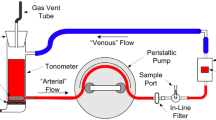Abstract
Pulse oximeters are known to be inaccurate in the presence of elevated concentrations of carboxyhemoglobin and methemoglobin. This paper attempts to alleviate some of the confusion that exists between fractional and functional saturation, and to clarify the comparison of each with SpO2. A series of theoretical relationships between pulse oximeter reading (SpO2) and actual oxygen saturation (both fractional and functional) is derived using simple absorption theory. The theoretical relationships are checked using an experimental in vitro test system. This consists of a blood circuit containing a model finger, capable of simulating the pulsatile transmission signals through a real finger. Theoretical predictions and experimental results are compared and are found to agree well in the presence of carboxyhemoglobin, but less well with methemoglobin. Possible reasons are discussed.
Similar content being viewed by others
References
Stewart RD, Baretta ED, Platte LR, Stewart EB, Kalbfleisch JH, Van Yserloo B, Rimm AA. Carboxyhemoglobin levels in American blood donors. JAMA 1974;229:1187–1195
Zander R. Concentrations of carboxyhemoglobin in the blood of smokers and non-smokers. In: Zander R, Mertzlufft F, eds. The oxygen status of arterial blood. Basel: Karger, 1991:184–189
Clark CJ, Campbell D, Reid WH. Blood carboxyhemoglobin and cyanide levels in fire survivors. Lancet 1981;1:1332–1335
Tada K, Tokaji A, Odaka Y, Kurasako T, Mutoh J, Takatori M, Morimoto N, Matsumoto M, Kosaka F. A resuscitation puzzle: acute acquired methemoglobinemia. Crit Care Med 1987;15:614–615
Anderson ST, Hajduczek J, Barker SJ. Benzocaine-induced methemoglobinemia in an adult: accuracy of pulse oximetry with methemoglobinemia. Anesth Analg 1988;67:1099–1101
Curry S. Methemoglobinemia. Ann Emerg Med 1982;11:214–221
Barker SJ. Carboxyhemoglobin and pulse oximetry. Anesthesiology 1988;68:301 (letter)
Van Assendelft OW. Spectrophotometry of haemoglobin derivatives. Assen, The Netherlands: Royal van Gorcum Ltd, 1970
Barker SJ, Tremper KK. The effect of carbon monoxide inhalation on pulse oximetry and transcutaneous PO2. Anesthesiology 1987;66:677–679
Vegfors M, Lenmarken C. Carboxyhaemoglobinaemia and pulse oximetry. Br J Anaesth 1991;66:625–626
Barker SJ, Tremper KK, Hyatt J. Effects of methemoglobinemia on pulse oximetry and mixed venous oximetry. Anesthesiology 1989;70:112–117
Eisenkraft JB. Pulse oximeter desaturation due to methemoglobinemia. Anesthesiology 1988;68:279–282
Kelleher JF. Pulse oximetry. J Clin Monit 1989;5:37–62
Ralston AC, Webb RK, Runciman WB. Potential errors in pulse oximetry. III. Effects of interference, dyes, dyshaemoglobins and other pigments. Anaesthesia 1991;46:291–295
Nellcor N-200(E) pulse oximeter operator's manual. Hayward, CA: Nellcor, 1987:37
Zijlstra WG, Oeseburg B. Definition and notation of hemoglobin oxygen saturation. IEEE Trans Biomed Eng 1989;36:872
de Kock JP, Reynolds KJ, Tarassenko L, Moyle JTB. The effect of varying LED intensity on pulse oximeter accuracy. J Med Eng Technol 1991;15:111–115
Reynolds KJ, de Kock JP, Tarassenko L, Moyle JTB. The temperature dependence of LEDs and its theoretical effect on pulse oximetry. Br J Anaesth 1991;67:638–643
Pologe JA. Pulse oximetry: technical aspects of machine design. Int Anesthesiol Clin 1987;25:137–153
Reynolds KJ, Moyle JTB, Sykes MK, Hahn CEW. Response of 10 pulse oximeters to an in vitro test system. Br J Anaesth 1992;68:365–369
Tremper KK, Barker SJ. Pulse oximetry. Anesthesiology 1989;70:98–108
Author information
Authors and Affiliations
Rights and permissions
About this article
Cite this article
Reynolds, K.J., Palayiwa, E., Moyle, J.T.B. et al. The effect of dyshemoglobins on pulse oximetry: Part I, theoretical approach and part II, experimental results using an in vitro test system. J Clin Monitor Comput 9, 81–90 (1993). https://doi.org/10.1007/BF01616919
Received:
Revised:
Accepted:
Issue Date:
DOI: https://doi.org/10.1007/BF01616919




